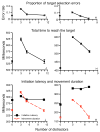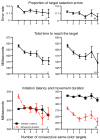Target selection for visually guided reaching in macaque
- PMID: 17989239
- PMCID: PMC2365509
- DOI: 10.1152/jn.01106.2007
Target selection for visually guided reaching in macaque
Abstract
We examined target selection for visually guided reaching in monkeys using a visual search task in which an odd-colored target was presented with distractors. The colors of the target and distractors were randomly switched in each trial between red and green, and the number of distractors was varied. Previous studies of saccades and attention have shown that target selection in this task is easier when a greater number of homogenous distractors is present. We found that monkeys made fewer reaches to distractors and that reaches to the target were completed more quickly when a greater number of homogenous distractors was present. When the target was presented in a sparse array of distractors, reaches had longer movement durations and greater trajectory curvature. Reaching errors were directed more often to a distractor adjacent to the target, suggesting a spatially coarse-to-fine progression during target selection. Reaches were also influenced by the properties of trials in the recent past. When the colors of the target and distractors remained the same from trial to trial rather than switching, reaches were completed more quickly and accurately, indicating that color priming across trials facilitates target selection. Moreover, when difficult search trials were randomly intermixed with easier trials without distractors, reach latencies were influenced by the difficulty of previous trials, indicating that motor initiation strategies are gradually adjusted based on accumulated experience. Overall, these results are consistent with reaching results in humans, indicating that the monkey provides a sound model for understanding the neural underpinnings of reach target selection.
Figures







Similar articles
-
Eye-hand coordination during target selection in a pop-out visual search.J Neurophysiol. 2009 Nov;102(5):2681-92. doi: 10.1152/jn.91352.2008. Epub 2009 Sep 2. J Neurophysiol. 2009. PMID: 19726722 Free PMC article.
-
Target selection in visual search as revealed by movement trajectories.Vision Res. 2008 Mar;48(7):853-61. doi: 10.1016/j.visres.2007.12.015. Epub 2008 Feb 11. Vision Res. 2008. PMID: 18262583
-
Influence of stimulus color on the control of reaching-grasping movements.Exp Brain Res. 2001 Mar;137(1):36-44. doi: 10.1007/s002210000639. Exp Brain Res. 2001. PMID: 11310170
-
Fixation offset facilitates saccades and manual reaching for single but not multiple target displays.Exp Brain Res. 2007 Feb;177(2):223-32. doi: 10.1007/s00221-006-0667-4. Epub 2006 Sep 1. Exp Brain Res. 2007. PMID: 16947063
-
Properties of saccadic responses in monkey when multiple competing visual stimuli are present.J Neurophysiol. 2004 Feb;91(2):890-900. doi: 10.1152/jn.00818.2003. Epub 2003 Oct 15. J Neurophysiol. 2004. PMID: 14561691
Cited by
-
Roles of narrow- and broad-spiking dorsal premotor area neurons in reach target selection and movement production.J Neurophysiol. 2010 Apr;103(4):2124-38. doi: 10.1152/jn.00238.2009. Epub 2010 Feb 17. J Neurophysiol. 2010. PMID: 20164405 Free PMC article.
-
Reversal of a distractor effect on saccade target selection after superior colliculus inactivation.J Neurophysiol. 2008 May;99(5):2694-702. doi: 10.1152/jn.00591.2007. Epub 2008 Mar 26. J Neurophysiol. 2008. PMID: 18367699 Free PMC article.
-
Global attention facilitates the planning, but not execution of goal-directed reaches.J Vis. 2016 Jul 1;16(9):7. doi: 10.1167/16.9.7. J Vis. 2016. PMID: 27467450 Free PMC article.
-
Allocation of attention for dissociated visual and motor goals.Exp Brain Res. 2013 Apr;226(2):209-19. doi: 10.1007/s00221-013-3426-3. Epub 2013 Feb 16. Exp Brain Res. 2013. PMID: 23417647
-
Statistical extraction affects visually guided action.Vis cogn. 2014 Jul 1;22(7):881-895. doi: 10.1080/13506285.2014.927044. Vis cogn. 2014. PMID: 25383014 Free PMC article.
References
-
- Andersen RA, Essick GK, Siegel RM. Encoding of spatial location by posterior parietal neurons. Science. 1985;230:456–458. - PubMed
-
- Arai K, McPeek RM, Keller EL. Properties of saccadic responses in monkey when multiple competing visual stimuli are present. J Neurophysiol. 2004;91:890–900. - PubMed
-
- Ballard D, Hayhoe M, Pook P, Rao R. Deictic codes for the embodiment of cognition. Behav Brain Sci. 1997;20:723–767. - PubMed
-
- Bichot NP, Schall JD. Effects of similarity and history on neural mechanisms of visual selection. Nat Neurosci. 1999;2:549–554. - PubMed
Publication types
MeSH terms
Grants and funding
LinkOut - more resources
Full Text Sources
Miscellaneous

